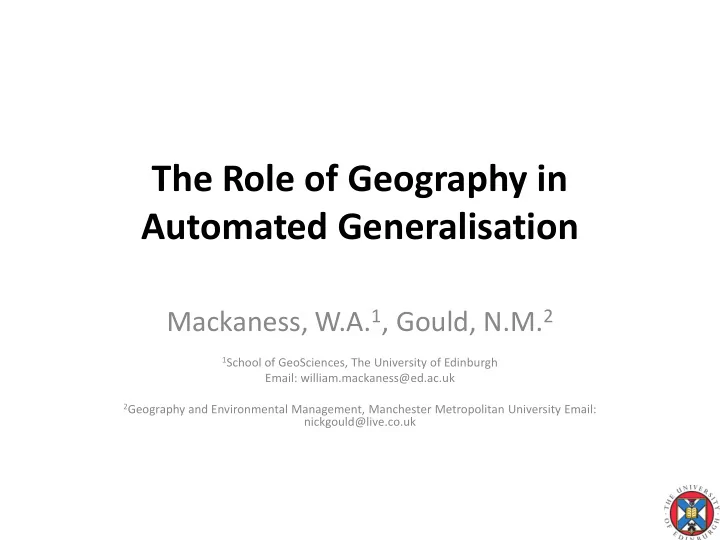

The Role of Geography in Automated Generalisation Mackaness, W.A. 1 , Gould, N.M. 2 1 School of GeoSciences, The University of Edinburgh Email: william.mackaness@ed.ac.uk 2 Geography and Environmental Management, Manchester Metropolitan University Email: nickgould@live.co.uk
Key message • A need to explore beyond the topographic • Revise our thinking about what the purpose of generalisation is: making sense of things • Stress the importance of the geographic in the design task 17 th ICA Workshop of the ICA Commission on 2 Generalisation and Multiple Representation
A topographic legacy Focus on the topographic: • Frameworks for generalising existing data • Task: data reduction • Customer: generalist • Question: open ended 17 th ICA Workshop of the ICA Commission on 3 Generalisation and Multiple Representation
A thematic perspective: Instead: • Start from a blank canvas • Start with a question: ‘A map showing the name / location of the 10 longest rivers in the world please’ 17 th ICA Workshop of the ICA Commission on 4 Generalisation and Multiple Representation
17 th ICA Workshop of the ICA Commission on 5 Generalisation and Multiple Representation
geographic 1. Models that link the query/ task to reasoning: the selection of scale • 10 longest rivers requires a global image • Salient info: 10 rivers can fit on A4/A5 paper • So a scale 1: 150,000,000 seems fair 17 th ICA Workshop of the ICA Commission on 6 Generalisation and Multiple Representation
geographic 2. Models that select contextual content reasoning: based on salient content Geographical context is fundamental to meaning • Salient: rivers (length, name) for the whole world • Dataset of ‘lake systems’, (density, size, name); • Contextualising: • Outline of the continents (name) • relief map of the world (height information) • Dataset of sea regions (name, depth) 17 th ICA Workshop of the ICA Commission on 7 Generalisation and Multiple Representation
cartographic 3. Content Models linked to reasoning: generalisation methods • What if we modify the task: say, show the 30 longest rivers? • Would A5/ 1: 150,000,000 no longer be suitable? • Solution: A5 but with continents colour coded according to how many rivers per continent 17 th ICA Workshop of the ICA Commission on 8 Generalisation and Multiple Representation
Longest rivers by continent 17 th ICA Workshop of the ICA Commission on 9 Generalisation and Multiple Representation
geographic 4. Saliency/ contextual models that control reasoning: the choice & degree of generalisation method • Salient information is generalised differently from contextual information • Less detail in the contextual, softer choice of colours • Greater flexibility in removal of contextual if salient not sufficiently discernible 17 th ICA Workshop of the ICA Commission on 10 Generalisation and Multiple Representation
geographic 5. Scale models that govern the importance reasoning: ascribed to different content hierarchies • Salient/contextual: not a binary. Deltas for example: 17 th ICA Workshop of the ICA Commission on 11 Generalisation and Multiple Representation
geographic 6: Explicit modelling/ preservation of reasoning: relationships during map generalisation • Geography of the relationship between entities imposes constraints on the generalisation process. 17 th ICA Workshop of the ICA Commission on 12 Generalisation and Multiple Representation
geographic 7: generalisation algorithms sensitive to the reasoning: behaviour of the entity • Geography governs the form of generalisation • For example: generalisation of natural a cyclic networks is different from anthropogenic ones. 17 th ICA Workshop of the ICA Commission on 13 Generalisation and Multiple Representation
• ‘cartographic generalisation will not reduce to a solution by a lock-step set of deterministic rules’ Armstrong 1991, p86 • ‘progress in cartographic generalisation will be achieved by attempting to model and generalise real world objects rather than their cartographic representation’ Mark 1991 p104 • We need to model ‘internal meaning’ – properties specific to the entity, AND ‘external meaning’ – relationships among other phenomena. (Nyerges 1991) 17 th ICA Workshop of the ICA Commission on 14 Generalisation and Multiple Representation
Ontological A need to explicitly model the modelling: relationships between entities 17 th ICA Workshop of the ICA Commission on 15 Generalisation and Multiple Representation
17 th ICA Workshop of the ICA Commission on 17 Generalisation and Multiple Representation
Conclusion 17 th ICA Workshop of the ICA Commission on 19 Generalisation and Multiple Representation
Conclusion A reasoning system is only as effective as the geographical knowledge that informs it. We need to ensure that geography centrally underpins all that we do in map generalisation. From an epistemological perspective, map generalisation should be about revealing different patterns and relationships among geographic phenomena 17 th ICA Workshop of the ICA Commission on 20 Generalisation and Multiple Representation
Recommend
More recommend